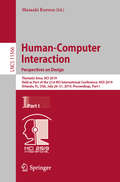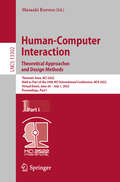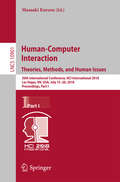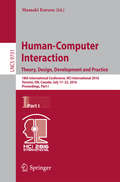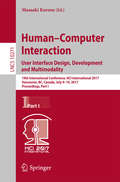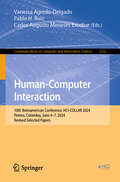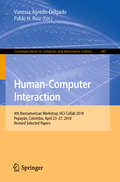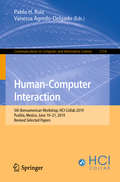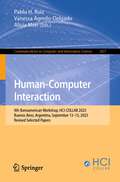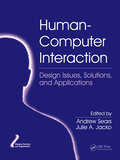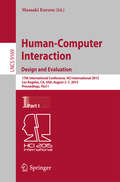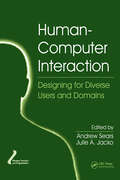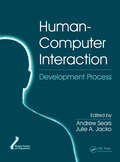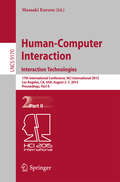- Table View
- List View
Human-Computer Interaction. Perspectives on Design: Thematic Area, HCI 2019, Held as Part of the 21st HCI International Conference, HCII 2019, Orlando, FL, USA, July 26–31, 2019, Proceedings, Part I (Lecture Notes in Computer Science #11566)
by Masaaki KurosuThe 3 volume-set LNCS 11566, 11567 + 11568 constitutes the refereed proceedings of the Human Computer Interaction thematic area of the 21st International Conference on Human-Computer Interaction, HCII 2019, which took place in Orlando, Florida, USA, in July 2019. A total of 1274 papers and 209 posters have been accepted for publication in the HCII 2019 proceedings from a total of 5029 submissions. The 125 papers included in this HCI 2019 proceedings were organized in topical sections as follows: Part I: design and evaluation methods and tools; redefining the human in HCI; emotional design, Kansei and aesthetics in HCI; and narrative, storytelling, discourse and dialogue. Part II: mobile interaction; facial expressions and emotions recognition; eye-gaze, gesture and motion-based interaction; and interaction in virtual and augmented reality. Part III: design for social challenges; design for culture and entertainment; design for intelligent urban environments; and design and evaluation case studies.
Human-Computer Interaction. Recognition and Interaction Technologies: Thematic Area, HCI 2019, Held as Part of the 21st HCI International Conference, HCII 2019, Orlando, FL, USA, July 26–31, 2019, Proceedings, Part II (Lecture Notes in Computer Science #11567)
by Masaaki KurosuThe 3 volume-set LNCS 11566, 11567 + 11568 constitutes the refereed proceedings of the Human Computer Interaction thematic area of the 21st International Conference on Human-Computer Interaction, HCII 2019, which took place in Orlando, Florida, USA, in July 2019. A total of 1274 papers and 209 posters have been accepted for publication in the HCII 2019 proceedings from a total of 5029 submissions. The 125 papers included in this HCI 2019 proceedings were organized in topical sections as follows: Part I: design and evaluation methods and tools; redefining the human in HCI; emotional design, Kansei and aesthetics in HCI; and narrative, storytelling, discourse and dialogue. Part II: mobile interaction; facial expressions and emotions recognition; eye-gaze, gesture and motion-based interaction; and interaction in virtual and augmented reality. Part III: design for social challenges; design for culture and entertainment; design for intelligent urban environments; and design and evaluation case studies.
Human-Computer Interaction. Theoretical Approaches and Design Methods: Thematic Area, HCI 2022, Held as Part of the 24th HCI International Conference, HCII 2022, Virtual Event, June 26–July 1, 2022, Proceedings, Part I (Lecture Notes in Computer Science #13302)
by Masaaki KurosuThe three-volume set LNCS 13302, 13303 and 13304 constitutes the refereed proceedings of the Human Computer Interaction thematic area of the 24th International Conference on Human-Computer Interaction, HCII 2022, which took place virtually in June-July 2022. The 132 papers included in this HCI 2022 proceedings were organized in topical sections as follows: Part I: Theoretical and Multidisciplinary Approaches in HCI; Design and Evaluation Methods, Techniques and Tools; Emotions and Design; and Children-Computer Interaction, Part II: Novel Interaction Devices, Methods and Techniques; Text, Speech and Image Processing in HCI; Emotion and Physiological Reactions Recognition; and Human-Robot Interaction, Part III: Design and User Experience Case Studies, Persuasive Design and Behavioral Change; and Interacting with Chatbots and Virtual Agents.
Human-Computer Interaction. Theories, Methods, and Human Issues: 20th International Conference, HCI International 2018, Las Vegas, NV, USA, July 15–20, 2018, Proceedings, Part I (Lecture Notes in Computer Science #10901)
by Masaaki KurosuThe 3 volume-set LNCS 10901, 10902 + 10903 constitutes the refereed proceedings of the 20th International Conference on Human-Computer Interaction, HCI 2018, which took place in Las Vegas, Nevada, in July 2018. The total of 1171 papers and 160 posters included in the 30 HCII 2018 proceedings volumes was carefully reviewed and selected from 4346 submissions. HCI 2018 includes a total of 145 papers; they were organized in topical sections named: Part I: HCI theories, methods and tools; perception and psychological issues in HCI; emotion and attention recognition; security, privacy and ethics in HCI. Part II: HCI in medicine; HCI for health and wellbeing; HCI in cultural heritage; HCI in complex environments; mobile and wearable HCI. Part III: input techniques and devices; speech-based interfaces and chatbots; gesture, motion and eye-tracking based interaction; games and gamification.
Human-Computer Interaction. Theory, Design, Development and Practice
by Masaaki KurosuThe 3-volume set LNCS 9731, 9732, and 9733 constitutes the refereed proceedings of the 18th International Conference on Human-Computer Interaction, HCII 2016, held in Toronto, ON, Canada, in July 2016. The total of 1287 papers presented at the HCII 2016 conferences was carefully reviewed and selected from 4354 submissions. The papers thoroughly cover the entire field of Human-Computer Interaction, addressing major advances in knowledge and effective use of computers in a variety of application areas. The volumes constituting the full 27-volume set of the conference proceedings are listed on pages VII and VIII.
Human-Computer Interaction. Theory, Methods and Tools: Thematic Area, HCI 2021, Held as Part of the 23rd HCI International Conference, HCII 2021, Virtual Event, July 24–29, 2021, Proceedings, Part I (Lecture Notes in Computer Science #12762)
by Masaaki KurosuThe three-volume set LNCS 12762, 12763, and 12764 constitutes the refereed proceedings of the Human Computer Interaction thematic area of the 23rd International Conference on Human-Computer Interaction, HCII 2021, which took place virtually in July 2021.The total of 1276 papers and 241 posters included in the 39 HCII 2021 proceedings volumes was carefully reviewed and selected from 5222 submissions. The 139 papers included in this HCI 2021 proceedings were organized in topical sections as follows: Part I, Theory, Methods and Tools: HCI theory, education and practice; UX evaluation methods, techniques and tools; emotional and persuasive design; and emotions and cognition in HCI Part II, Interaction Techniques and Novel Applications: Novel interaction techniques; human-robot interaction; digital wellbeing; and HCI in surgery Part III, Design and User Experience Case Studies: Design case studies; user experience and technology acceptance studies; and HCI, social distancing, information, communication and work
Human-Computer Interaction. User Experience and Behavior: Thematic Area, HCI 2022, Held as Part of the 24th HCI International Conference, HCII 2022, Virtual Event, June 26 – July 1, 2022, Proceedings, Part III (Lecture Notes in Computer Science #13304)
by Masaaki KurosuThe three-volume set LNCS 13302, 13303 and 13304 constitutes the refereed proceedings of the Human Computer Interaction thematic area of the 24th International Conference on Human-Computer Interaction, HCII 2022, which took place virtually in June-July 2022. The 132 papers included in this HCI 2022 proceedings were organized in topical sections as follows: Part I: Theoretical and Multidisciplinary Approaches in HCI; Design and Evaluation Methods, Techniques and Tools; Emotions and Design; and Children-Computer Interaction, Part II: Novel Interaction Devices, Methods and Techniques; Text, Speech and Image Processing in HCI; Emotion and Physiological Reactions Recognition; and Human-Robot Interaction, Part III: Design and User Experience Case Studies, Persuasive Design and Behavioral Change; and Interacting with Chatbots and Virtual Agents.
Human-Computer Interaction. User Interface Design, Development and Multimodality
by Masaaki KurosuThe two-volume set LNCS 10271 and 10272 constitutes the refereed proceedings of the 19th International Conference on Human-Computer Interaction, HCII 2017, held in Vancouver, BC, Canada, in July 2017. The total of 1228 papers presented at the 15 colocated HCII 2017 conferences was carefully reviewed and selected from 4340 submissions. The papers address the latest research and development efforts and highlight the human aspects of design and use of computing systems. They cover the entire field of Human-Computer Interaction, addressing major advances in knowledge and effective use of computers in a variety of application areas. The papers included in this volume cover the following topics: HCI theory and education; HCI, innovation and technology acceptance; interaction design and evaluation methods; user interface development; methods, tools, and architectures; multimodal interaction; and emotions in HCI.
Human-Computer Interaction: 10th Iberoamerican Conference, HCI-COLLAB 2024, Pereira, Colombia, June 4–7, 2024, Revised Selected Papers (Communications in Computer and Information Science #2332)
by Vanessa Agredo-Delgado Pablo H. Ruiz Carlos Augusto Meneses EscobarThis book constitutes the refereed proceedings of the 10th Iberoamerican Conference on Human-Computer Interaction, HCI-COLLAB 2024, held in Pereira, Colombia, during June 4–7, 2024. The 26 full papers presented here were carefully selected and reviewed from 85 submissions. Among the topics addressed in this edition were key areas such as accessibility, usability, video games and gamification, computational thinking, Internet of Things (IoT), software engineering, information and communication technologies (ICT) in education, virtual, augmented and mixed reality applied to education, artificial intelligence in HCI, industry 4.0, infotainment systems, collaborative work and learning, cognition and interaction. The diversity and topicality of these topics reflect the breadth of the discipline and its relevance to meet the technological and social challenges of today's world.
Human-Computer Interaction: 4th Iberoamerican Workshop, Hci-collab 2018, Popayán, Colombia, April 23-27, 2018, Revised Selected Papers (Communications In Computer And Information Science #847)
by Vanessa Agredo-Delgado Pablo H. RuizThis book constitutes the thoroughly refereed proceedings of the 4th Iberoamerican Workshop on Human-Computer Interaction, HCI-Collab 2018, held in Popayán, Colombia, in April 2018. The 18 full papers presented in this volume were carefully reviewed and selected from 83 submissions. The papers are dealing with topics such as emotional interfaces, HCI and videogames, computational thinking, collaborative systems, software engineering and ICT in education.
Human-Computer Interaction: 5th Iberoamerican Workshop, HCI-Collab 2019, Puebla, Mexico, June 19–21, 2019, Revised Selected Papers (Communications in Computer and Information Science #1114)
by Vanessa Agredo-Delgado Pablo H. RuizThis book constitutes the proceedings of the 5th Iberoamerican Workshop on Human-Computer Interaction, HCI-Collab 2019, held in Puebla, Mexico, in June 2019.The 31 full papers presented in this volume were carefully reviewed and selected from 55 submissions. The papers describe models, design patterns, implementations, evaluations of existing applications, and systemic reviews; all of which are very important aspects within HCI.
Human-Computer Interaction: 6th Iberomarican Workshop, HCI-Collab 2020, Arequipa, Peru, September 16–18, 2020, Proceedings (Communications in Computer and Information Science #1334)
by Vanessa Agredo-Delgado Pablo H. Ruiz Klinge Orlando Villalba-CondoriThis book constitutes the thoroughly refereed proceedings of the 6th Iberoamerican Workshop on Human-Computer Interaction, HCI-Collab 2020, held in Arequipa, Peru, in September 2020.*The 28 full and 3 short papers presented in this volume were carefully reviewed and selected from 128 submissions. The papers deal with topics such as emotional interfaces, usability, video games, computational thinking, collaborative systems, IoT, software engineering, ICT in education, augmented and mixed virtual reality for education, gamification, emotional Interfaces, adaptive instruction systems, accessibility, use of video games in education, artificial Intelligence in HCI, among others. *The workshop was held virtually due to the COVID-19 pandemic.
Human-Computer Interaction: 7th Iberoamerican Workshop, HCI-COLLAB 2021, Sao Paulo, Brazil, September 8–10, 2021, Proceedings (Communications in Computer and Information Science #1478)
by Vanessa Agredo-Delgado Pablo H. Ruiz André Luiz Satoshi KawamotoThis book constitutes the thoroughly refereed proceedings of the 7th Iberoamerican Workshop on Human-Computer Interaction, HCI-Collab 2021, held in Sao Paulo, Brazil, in September 2021.*The 15 full and 4 short papers presented in this volume were carefully reviewed and selected from 68 submissions. The papers deal with topics such as emotional interfaces, usability, video games, computational thinking, collaborative systems, IoT, software engineering, ICT in education, augmented and mixed virtual reality for education, gamification, emotional Interfaces, adaptive instruction systems, accessibility, use of video games in education, artificial Intelligence in HCI, among others.*The workshop was held virtually due to the COVID-19 pandemic.
Human-Computer Interaction: 8th Iberoamerican Workshop, HCI-COLLAB 2022, Havana, Cuba, October 13–15, 2022, Revised Selected Papers (Communications in Computer and Information Science #1707)
by Vanessa Agredo-Delgado Pablo H. Ruiz Omar Correa-MadrigalThis book constitutes the refereed proceedings of the 8th Iberoamerican Workshop on Human-Computer Interaction, HCI-COLLAB 2022, which took place in Havana, Cuba, in October 2022. The 15 full papers presented in this volume were carefully reviewed and selected from 53 submissions. The papers deal with topics such as emotional interfaces, usability, video games, computational thinking, collaborative systems, IoT, software engineering, ICT in education, augmented and mixed virtual reality for education, gamification, emotional interfaces, adaptive instructional systems, accessibility, use of video games in education, artificial intelligence in HCI and infotainment, among others.
Human-Computer Interaction: 9th Iberoamerican Workshop, HCI-COLLAB 2023, Buenos Aires, Argentina, September 13–15, 2023, Revised Selected Papers (Communications in Computer and Information Science #1877)
by Vanessa Agredo-Delgado Pablo H. Ruiz Alicia MonThis book constitutes the referred proceedings of the 9th Iberoamerican Workshop on Human-Computer Interaction, HCI-COLLAB 2023, held in Buenos Aires, Argentina, during September 13–15, 2023. The 23 full papers presented in this book were carefully reviewed and selected from 84 submissions. They cover a variety of topics related to HCI such as: Emotional Interfaces, Usability, Video Games and Gamification, Computational Thinking, Internet of Things (IoT), Software Engineering, ICT in Education, Augmented and Mixed Virtual Reality for Education, Emotional Interfaces, Adaptive Instructional Systems, Accessibility, Artificial Intelligence in HCI, Industry 4. 0 and HCI, Infotainment Systems, Intelligent Systems, Collaborative Work and Learning, Cognition, and Interaction, among others.
Human-Computer Interaction: Design Issues, Solutions, and Applications (Human Factors and Ergonomics)
by Julie A. Jacko Andrew SearsHailed on first publication as a compendium of foundational principles and cutting-edge research, The Human-Computer Interaction Handbook has become the gold standard reference in this field. Derived from select chapters of this groundbreaking resource, Human-Computer Interaction: Design Issues, Solutions, and Applications focuses on HCI from a pri
Human-Computer Interaction: Design and Evaluation
by Masaaki KurosuThe 3-volume set LNCS 9169, 9170, 9171 constitutes the refereed proceedings of the 17th International Conference on Human-Computer Interaction, HCII 2015, held in Los Angeles, CA, USA, in August 2015. The total of 1462 papers and 246 posters presented at the HCII 2015 conferences was carefully reviewed and selected from 4843 submissions. These papers address the latest research and development efforts and highlight the human aspects of design and use of computing systems. The papers in LNCS 9169 are organized in topical sections on HCI theory and practice; HCI design and evaluation methods and tools; interaction design; emotions in HCI.
Human-Computer Interaction: Designing for Diverse Users and Domains (Human Factors and Ergonomics)
by Julie A. Jacko Andrew SearsHailed on first publication as a compendium of foundational principles and cutting-edge research, The Human-Computer Interaction Handbook has become the gold standard reference in this field. While human-computer interaction may have emerged from within computing, significant contributions have come from a variety of fields including industrial engineering, psychology, education, and graphic design. No where is this more apparent then when designing solutions for users as diverse as children, older adults, and individuals with physical, cognitive, visual, or hearing impairments. Derived from select chapters in The Human-Computer Interaction Handbook, this volume emphasizes design for these groups and also discusses HCI in the context of specific domains including healthcare, games, and the aerospace industry.
Human-Computer Interaction: Development Process (Human Factors and Ergonomics)
by Julie A. Jacko Andrew SearsHailed on first publication as a compendium of foundational principles and cutting-edge research, The Human-Computer Interaction Handbook has become the gold standard reference in this field. Derived from select chapters of this groundbreaking resource, Human-Computer Interaction: The Development Practice addresses requirements specification, desig
Human-Computer Interaction: Interaction Technologies
by Masaaki KurosuThe 3-volume set LNCS 9169, 9170, 9171 constitutes the refereed proceedings of the 17th International Conference on Human-Computer Interaction, HCII 2015, held in Los Angeles, CA, USA, in August 2015. The total of 1462 papers and 246 posters presented at the HCII 2015 conferences was carefully reviewed and selected from 4843 submissions. These papers address the latest research and development efforts and highlight the human aspects of design and use of computing systems. The papers in LNCS 9170 are organized in topical sections on gesture and eye-gaze based interaction; touch-based and haptic interaction; natural user interfaces; adaptive and personalized interfaces; distributed, migratory and multi-screen user interfaces; games and gamification; HCI in smart and intelligent environments.
Human-Computer Interaction: Thematic Area, HCI 2023, Held as Part of the 25th HCI International Conference, HCII 2023, Copenhagen, Denmark, July 23–28, 2023, Proceedings, Part I (Lecture Notes in Computer Science #14011)
by Masaaki Kurosu Ayako HashizumeThe four-volume set LNCS 14011, 14012, 14013, and 14014 constitutes the refereed proceedings of the Human Computer Interaction thematic area of the 25th International Conference on Human-Computer Interaction, HCII 2023, which took place in Copenhagen, Denmark, in July 2023. A total of 1578 papers and 396 posters have been accepted for publication in the HCII 2023 proceedings from a total of 7472 submissions. The papers included in the HCI 2023 volume set were organized in topical sections as follows: Part I: Design and evaluation methods, techniques and tools; interaction methods and techniques; Part II: Children computer interaction; emotions in HCI; and understanding the user experience; Part III: Human robot interaction; chatbots and voice-based interaction; interacting in the metaverse; Part IV: Supporting health, quality of life and everyday activities; HCI for learning, culture, creativity and societal impact.
Human-Computer Interaction: Thematic Area, HCI 2023, Held as Part of the 25th HCI International Conference, HCII 2023, Copenhagen, Denmark, July 23–28, 2023, Proceedings, Part II (Lecture Notes in Computer Science #14012)
by Masaaki Kurosu Ayako HashizumeThe four-volume set LNCS 14011, 14012, 14013, and 14014 constitutes the refereed proceedings of the Human Computer Interaction thematic area of the 25th International Conference on Human-Computer Interaction, HCII 2023, which took place in Copenhagen, Denmark, in July 2023. A total of 1578 papers and 396 posters have been accepted for publication in the HCII 2023 proceedings from a total of 7472 submissions. The papers included in the HCI 2023 volume set were organized in topical sections as follows: Part I: Design and evaluation methods, techniques and tools; interaction methods and techniques; Part II: Children computer interaction; emotions in HCI; and understanding the user experience; Part III: Human robot interaction; chatbots and voice-based interaction; interacting in the metaverse; Part IV: Supporting health, quality of life and everyday activities; HCI for learning, culture, creativity and societal impact.
Human-Computer Interaction: Thematic Area, HCI 2023, Held as Part of the 25th HCI International Conference, HCII 2023, Copenhagen, Denmark, July 23–28, 2023, Proceedings, Part III (Lecture Notes in Computer Science #14013)
by Masaaki Kurosu Ayako HashizumeThe four-volume set LNCS 14011, 14012, 14013, and 14014 constitutes the refereed proceedings of the Human Computer Interaction thematic area of the 25th International Conference on Human-Computer Interaction, HCII 2023, which took place in Copenhagen, Denmark, in July 2023. A total of 1578 papers and 396 posters have been accepted for publication in the HCII 2023 proceedings from a total of 7472 submissions. The papers included in the HCI 2023 volume set were organized in topical sections as follows: Part I: Design and evaluation methods, techniques and tools; interaction methods and techniques; Part II: Children computer interaction; emotions in HCI; and understanding the user experience; Part III: Human robot interaction; chatbots and voice-based interaction; interacting in the metaverse; Part IV: Supporting health, quality of life and everyday activities; HCI for learning, culture, creativity and societal impact.
Human-Computer Interaction: Thematic Area, HCI 2023, Held as Part of the 25th HCI International Conference, HCII 2023, Copenhagen, Denmark, July 23–28, 2023, Proceedings, Part IV (Lecture Notes in Computer Science #14014)
by Masaaki Kurosu Ayako HashizumeThe four-volume set LNCS 14011, 14012, 14013, and 14014 constitutes the refereed proceedings of the Human Computer Interaction thematic area of the 25th International Conference on Human-Computer Interaction, HCII 2023, which took place in Copenhagen, Denmark, in July 2023. A total of 1578 papers and 396 posters have been accepted for publication in the HCII 2023 proceedings from a total of 7472 submissions. The papers included in the HCI 2023 volume set were organized in topical sections as follows: Part I: Design and evaluation methods, techniques and tools; interaction methods and techniques; Part II: Children computer interaction; emotions in HCI; and understanding the user experience; Part III: Human robot interaction; chatbots and voice-based interaction; interacting in the metaverse; Part IV: Supporting health, quality of life and everyday activities; HCI for learning, culture, creativity and societal impact.
Human-Computer Interaction: Thematic Area, HCI 2024, Held as Part of the 26th HCI International Conference, HCII 2024, Washington, DC, USA, June 29 – July 4, 2024, Proceedings, Part I (Lecture Notes in Computer Science #14684)
by Masaaki Kurosu Ayako HashizumeThis five-volume set LNCS 14684-14688 constitutes the refereed proceedings of the Human Computer Interaction thematic area of the 26 International Conference on Human-Computer Interaction, HCII 2024, held in Washington, DC, USA, during June 29 – July 4, 2024. The total of 1271 papers and 309 posters included in the HCII 2024 proceedings was carefully reviewed and selected from 5108 submissions. The VAMR 2024 proceedings were organized in the following topical sections: Part I: HCI Theory and Design and Evaluation Methods and Tools; Emotions in HCI. Part II: Human-Robot Interaction; Child-Computer Interaction. Part III: HCI for Mental Health and Psychological Wellbeing; HCI in Healthcare. Part IV: HCI, Environment and Sustainability; Design and User Experience Evaluation Case Studies. Part V: Multimodality and Natural User Interfaces; HCI, AI, Creativity, Art and Culture.
